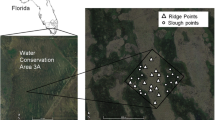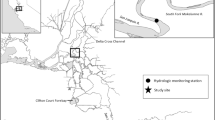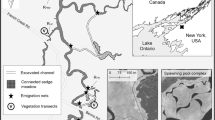Abstract
A decline in northern pike (Esox lucius) abundance in the upper St. Lawrence River is thought to be related to hybrid cattail invasion and disruption of natural water-level periodicity leading to spawning and nursery habitat degradation. Channel-connectivity and spawning-pool excavations were implemented in a tributary to the upper St. Lawrence River to enhance spawning and nursery site complexity. We assessed the effects of excavations on pike by comparing percent survival (from advanced larvae to fall emigration), water quality factors, and larval diets at excavated and non-excavated sites. Lab-reared pike, 16 days post-hatch and 14 mm in length, were released at three site types: non-excavated, spawning pool, and channel. Percent survival in channels and spawning pools after a minimum of 26 days was nearly identical (2.4%), and greater than non-excavated sites (0.13%). Spawning pools displayed higher water temperatures and dissolved-oxygen concentrations than either channel or non-excavated sites. Larvae primarily consumed zooplankton and diets of larvae from spawning pools and non-excavated sites were similar, whereas larvae in channels consumed different taxa. Differences in diet were not reflected in survival, suggesting larvae were not prey-limited. Observed differences in percent survival among sites demonstrates created spawning pool and channel-connectivity sites enhanced conditions for pike.





Similar content being viewed by others
References
Adelman JR, Smith LL (1970) Effect of oxygen on growth and food conversion efficiency of northern pike. Progressive Fish-Culturist 32:93–96
Amoros C (1984) Introduction pratique à la systématique des organismes des eaux continentales françaises - 5. Crustacés Cladocères. Bulletin Mensuel de La Société Linnéenne de Lyon 53:72–107
Badosa A, Frisch D, Arechederra A, Serrano L, Green AJ (2010) Recovery of zooplankton diversity in a restored Mediterranean temporary marsh in Doñana National Park (SW Spain). Hydrobiologia 654:67–82
Basu BK, Kalff J, Pinel-Alloul B (2000) Mid-summer plankton development along a large temperature river: the St. Lawrence River. Canadian Journal of Fisheries and Aquatic Sciences 57:7–15
Boers AM, Zedler JB (2008) Stabilized water levels and Typha invasiveness. Wetlands 28:676–685
Bosworth A, Farrell JM (2006) Genetic divergence among northern pike from spawning locations in the upper St. Lawrence River. North American Journal of Fisheries Management 26:676–684
Bry C (1996) Role of vegetation in the life cycle of pike. In: Craig JF (ed) Pike: biology and exploitation. Chapman and Hall, London, pp 45–67
Bry C, Bonamy F, Manelphe J, Duranthon B (1995) Early life characteristics of pike, Esox lucius, in rearing ponds: temporal survival pattern and ontogenetic diet shifts. Journal of Fish Biology 46:99–113
Burrow JF, Horwood JW, Pitchford JW (2011) The importance of variable timing and abundance of prey for fish larval recruitment. Journal of Plankton Research 33:1153–1162
Casselman JM (1978) Effects of environmental factors on growth, survival, activity, and exploitation of northern pike. American Fisheries Society Special Publication 11:114–128
Casselman JM, Lewis CA (1996) Habitat requirements of northern pike (Esox lucius). Canadian Journal of Fisheries and Aquatic Sciences 53:161–174
Chesson J (1978) Measuring preference in selective predation. Ecology 59:211–215
Chesson J (1983) The estimation and analysis of preference and its relationship to foraging models. Ecology 64:1297–1304
Cooper JE, Mead JV, Farrell JM, Werner RG (2008) Potential effects of spawning habitat changes on the segregation of northern pike (Esox lucius) and muskellunge (E. masquinongy) in the upper St. Lawrence River. Hydrobiologia 601:41–53
Cucherousset J, Paillisson JM, Cuzol A, Roussel JM (2009) Spatial behaviour of young-of-the-year northern pike (Esox lucius L.) in a temporarily flooded nursery area. Ecology of Freshwater Fish 18:314–322
Cushing DH (1974) The natural regulation of fish populations. In: Harden-Jones FR (ed) Sea fisheries research. John Wiley and Sons, New York, pp 399–412
Cushing DH (1990) Plankton production and year-class strength in fish populations: an update of the match/mismatch hypothesis. In: Larson SE, Lowry D (eds) Advances in marine biology. Academic Press, San Diego, pp 249–293
Dahlberg MD (1979) A review of survival rates of fish eggs and larvae in relation to impact assessments. Marine Fisheries Review 41:1–12
Dodson SI, Lillie RA (2001) Zooplankton communities of restored depressional wetlands in Wisconsin, USA. Wetlands 21:292–300
Fairchild GW (1981) Movement and microdistribution of Sida crystallina and other littoral microcrustacea. Ecology 62:1341–1352
Farrell JM (2001) Reproductive success of sympatric northern pike and muskellunge in an upper St. Lawrence River bay. Transactions of the American Fisheries Society 130:796–808
Farrell JM, Werner RG (1999) Distribution, abundance, and survival of age-0 muskellunge in upper St. Lawrence River nursery bays. North American Journal of Fisheries Management 19:309–320
Farrell JM, Mead JV, Murry BA (2006) Protracted spawning of St Lawrence river northern pike (Esox lucius): simulated effects on survival, growth, and production. Ecology of Freshwater Fish 15:169–179
Farrell JM, Holeck KT, Mills EL, Hoffman CE, Patil VJ (2010a) Recent ecological trends in lower trophic levels of the international section of the St. Lawrence River: a comparison of the 1970s to the 2000s. Hydrobiologia 647:21–33
Farrell JM, Murry BA, Leopold DJ, Halpern A, Rippke MB, Godwin KS, Hafner SD (2010b) Water-level regulation and coastal wetland vegetation in the upper St. Lawrence River: inferences from historical aerial imagery, seed banks, and Typha dynamics. Hydrobiologia 647:127–144
Farrell JM, Bachman C, Looi A, LaPan S, Regan M, Runner J, Schulz K, Mitchell MJ, Gibbs J, Leopold DJ (2014) Coastal fisheries habitat restoration in the St. Lawrence River: documenting project efficacy. Final Report Submitted to Ducks Unlimited and the National Oceanographic and Atmospheric Administration (NOAA) Coastal Fisheries Habitat Restoration Program
Farrell JM, Satre N, Augustyn EA (2015) Northern pike research, monitoring, and management in the Thousand Islands section of the St. Lawrence River. In 2015 NYSDEC Annual Report, Bureau of Fisheries Lake Ontario Unit and St. Lawrence River Unit to the Great Lakes Fishery Commission’s Lake Ontario Committee
Fielder DG (2002) Methodology for immersion marking walleye fry and fingerlings in oxytetracycline hydrochloride and its detection with fluorescence microscopy. Michigan Department of Natural Resources Fisheries Technical Report 2002-01: 1–21
Forney JL (1968) Production of young northern pike in a regulated marsh. New York Fish and Game Journal 15:143–154
Franklin DR, Smith LL Jr (1963) Early life history of the northern pike, Esox lucius L., with special reference to the factors influencing the numerical strength of year classes. Transactions of the American Fisheries Society 92:91–110
Grønkjær P, Skov C, Berg S (2004) Otolith-based analysis of survival and size-selective mortality of stocked 0+ year pike related to time of stocking. Journal of Fish Biology 64:1625–1637
Gutreuter S, Bartels AD, Irons K, Sandheinrich MB (1999) Evaluation of the flood-pulse concept based on statistical models of growth of selected fishes of the upper Mississippi River system. Canadian Journal of Fisheries and Aquatic Sciences 56:2282–2291
Hjort J (1914) Fluctuations in the great fisheries of northern Europe, viewed in the light of biological research. Rapports et Procès-Verbaux des Réunions du Conseil Permanent International pour l'Exploration de la Mer 20:1–228
Houde ED (1987) Fish early life dynamics and recruitment variability. American Fisheries Society Symposium 2:17–29
Hühn D, Lübke K, Skov C, Arlinghaus R, Taylor E (2014) Natural recruitment, density-dependent juvenile survival, and the potential for additive effects of stock enhancement: an experimental evaluation of stocking northern pike (Esox lucius) fry. Canadian Journal of Fisheries and Aquatic Sciences 71:1508–1519
Johnson FH (1957) Northern pike year-class strength and spring water levels. Transactions of the American Fisheries Society 86:285–293
Jude DJ, Pappas J (1992) Fish utilization of Great Lakes coastal wetlands. Journal of Great Lakes Research 18:651–672
Klingbiel J (1986) Culture of purebred muskellunge. American Fisheries Society Special Publication 15:273–378
Ljunggren L, Sandström A, Bergström U, Mattila J, Lappalainen A, Johansson G, Sundblad G, Casini M, Kaljuste O, Eriksson BK (2010) Recruitment failure of coastal predatory fish in the Baltic Sea is related to an offshore system shift. ICES Journal of Marine Science 67:1587–1595
Manly BFJ (1974) A model for certain types of selection experiments. Biometrics 30:281–294
Massa EA, Farrell JM (2019) Prey selection by larval northern pike (Esox lucius) exposed to different zooplankton assemblages representing seasonally-flooded wetland and nearshore bay habitats. Limnol Oceanogr 64:1200-1213
Mathers A, Hartley K (1995) Sawquin Creek marsh channel creation project. In: Kelso J, Hartig, J (eds) Methods of modifying habitat to benefit the Great Lakes ecosystem. CISTI (Canadian Institute of Science Technical Information) Occasional Paper No. 1, pp 197–199
Mayer CM, Wahl DH (1997) The relationship between prey selectivity and growth and survival in a larval fish. Canadian Journal of Fisheries and Aquatic Sciences 54:1504–1512
McCullough RD, Gordon DJ (2015) Thousand Islands warmwater fish stock assessment. In: New York State Department of Environmental Conservation. Lake Ontario Annual Report 2015 (St. Lawrence River), Section 6, pp 1–19
McKenna JE (2003a) An enhanced cluster analysis program with bootstrap significance testing for ecological community analysis. Environmental Modelling and Software 18:205–220
McKenna JE (2003b) Community metabolism during early development of a restored wetland. Wetlands 23:35–50
Mingelbier M, Brodeur P, Morin J (2008) Spatially explicit model predicting the spawning habitat and early stage mortality of northern pike (Esox lucius) in a large system: the St. Lawrence River between 1960 and 2000. Hydrobiologia 601:55–69
Neveldine BL, Leblanc JP, Farrell JM (2019). Vegetation response and juvenile northern pike (Esox lucius) outmigration following connectivity enhancement of a Typha dominated coastal wetland. Wetlands https://doi.org/10.1007/s13157-019-01145-y
Nilsson PA, Brönmark C (2000) Prey vulnerability to a gape-size limited predator: behavioural and morphological impacts on northern pike piscivory. Oikos 88:539–546
Nilsson J, Engstedt O, Larsson P (2014) Wetlands for northern pike (Esox lucius L.) recruitment in the Baltic Sea. Hydrobiologia 721:145–154
Nunn AD, Harvey JP, Cowx IG (2007) Benefits to 0+ fishes of connecting man-made waterbodies to the lower river Trent, England. River Research and Applications 23:361–376
Oele DL, Gaeta JW, Rypel AL, McIntyre PB (2019) Growth and recruitment dynamics of young-of-year northern pike: implications for habitat conservation and management. Ecology of Freshwater Fish 28:285–301
Raat, AJP (1988) Synopsis of biological data on the northern pike Esox lucius Linnaeus, 1758. FAO Fisheries Synopsis No. 30: 178 pp
Rippke MB, Distler MT, Farrell JM (2010) Holocene vegetation dynamics of an upper St. Lawrence River wetland: Paleoecological evidence for a recent increase in cattail (Typha). Wetlands 30:805–816
Skov C, Berg S (1999) Utilization of natural and artificial habitats by YOY pike in a biomanipulated lake. Hydrobiologia 408/409:115–122
Skov C, Nilsson PA (2007) Evaluating stocking of YOY pike Esox lucius as a tool in the restoration of shallow lakes. Freshwater Biology 52:1834–1845
Skov C, Jacobsen L, Berg S (2003) Post-stocking survival of 0+ year pike in ponds as a function of water transparency, habitat complexity, prey availability and size heterogeneity. Journal of Fish Biology 62:311–322
Skov C, Koed A, Baastrup-Spohr L, Arlinghaus R (2011) Dispersal, growth, and diet of stocked and wild northern pike fry in a shallow natural lake, with implications for the management of stocking programs. North American Journal of Fisheries Management 31:1177–1186
Smith BM, Farrell JM, Underwood HB, Smith SJ (2007) Year-class formation of upper St. Lawrence River northern pike. North American Journal of Fisheries Management 27:481–491
Sorenson L, Buss K, Bradford AD (1966) The artificial propagation of esocid fishes in Pennsylvania. Progressive Fish Culturist 28:133–141
Sutela T, Korhonen P, Nyberg K (2004) Stocking success of newly hatched pike evaluated by radioactive strontium (85Sr) marking. Journal of Fish Biology 64:653–664
Thorp JH, Covich AP (2001) Ecology and classification of North American freshwater invertebrates, 2nd edn. Academic Press, San Diego
Timm AL, Pierce RB (2015) Vegetative substrates used by larval northern pike in rainy and Kabetogama Lakes, Minnesota. Ecology of Freshwater Fish 24:225–233
Vincent J (1995) Toronto Islands northern pike spawning habitat. In: Kelso J, Hartig, J (eds) Methods of modifying habitat to benefit the Great Lakes ecosystem. CISTI (Canadian Institute of Science Technical Information) Occasional Paper No. 1, pp 139–144
Vuorinen P, Nyberg K, Lehtonen H (1998) Radioactive strontium (85Sr) in marking newly hatched pike and success of stocking. Journal of Fish Biology 52:268–280
Ward HB, Whipple GC (1959) Freshwater biology, 2nd edn. Wiley, New York
Wilcox DA, Xie Y (2007) Predicting wetland plant community responses to proposed water-level-regulation plans for Lake Ontario: GIS-based modeling. Journal of Great Lakes Research 33:751–773
Acknowledgments
Funding was provided by the Fish Enhancement, Mitigation, and Research Fund administered by the U.S. Fish and Wildlife Service (FWS), New York Field Office, Cortland, NY and the Environmental Protection Fund (contract # AM10165) administered by the NYSDEC. Excavations were funded by the FWS and Ducks Unlimited. We thank the 2016 TIBS crew for their hard work during the field season. We are grateful especially to Jay Palumbo who assisted in otolith dissection, preparation, and viewing. This research is a contribution of the Thousand Islands Biological Station.
Author information
Authors and Affiliations
Corresponding author
Additional information
Publisher’s Note
Springer Nature remains neutral with regard to jurisdictional claims in published maps and institutional affiliations.
Rights and permissions
About this article
Cite this article
Massa, E.A., Farrell, J.M. Improving Habitat Connectivity in a Typha-Dominated Wetland Shows Increased Larval Northern Pike Survival. Wetlands 40, 273–286 (2020). https://doi.org/10.1007/s13157-019-01177-4
Received:
Accepted:
Published:
Issue Date:
DOI: https://doi.org/10.1007/s13157-019-01177-4




